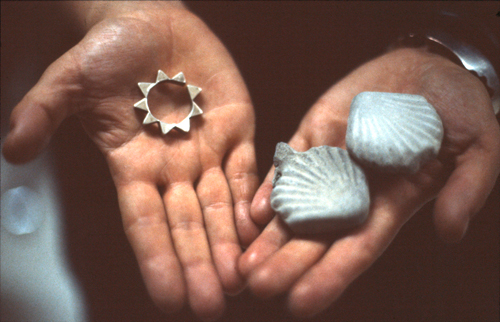Annette Wehrmann
Badischer Kunstverein
Badischer Kunstverein

The association that manages the estate of Annette Wehrmann, who died in 2010, calls itself ‘Ort des Gegen e.V.’ – Place of Opposition. This group was also involved in organizing Wehrmann’s exhibition Wir gucken fern, weil wir uns die Revolution nicht leisten können (We’re watching TV because we can’t afford the revolution) in Karlsruhe. ‘The PLACE OF OPPOSITION is the flipside of utopia, the third dimension’, Wehrmann wrote in 2002. With this slogan, Wehrmann called for an arena where rubbish and boredom could thrive, a ‘blank space without definition’, a purposeless space where counter models to utopia could be conceived.
The most recent of the works assembled in Karlsruhe, SCUM – ein UFO für V. Solanas (2007, SCUM – a UFO for V. Solanas), represents this form of anti-utopia. In an installation that fills an entire room, two orbits made of roofing battens and adhesive tape hang from the ceiling and are covered with quotes from Valerie Solanas’s famous SCUM Manifesto (1967). The installation is framed by phrases from Solanas’s manifesto that have been scrawled on the walls by hand, and a copy of the manifesto is also on display. The ‘planets’ in the orbit – three small, eccentrically hung disco balls – appear to have taken leave of their galaxy, much like women who, as per Solanas’s manifesto, have freed themselves from the repressive system of society to form the ‘unwork force’ of SCUM. In a 2008 interview that was published online, Annette Wehrmann offered the interviewer, the artist Sabine Falk (who is now a member of Ort des Gegen), an interpretation of Solanas’s radical feminist vision as a counter project parodying conventional science fiction narratives, which ultimately just follow the capitalist logic that society as a whole has internalized.
This is precisely what Wehrmann grappled with in her early works, such as her invented currency, DSB (DSB für die Zukunft, DSB for the Future, 1993–96), which she offered to passers-by in actions performed in public places. The possessor of these units of small concrete casts of shell-shaped soap would have to renegotiate their value at every transaction. Through this currency, the artist intended to develop an autonomous economic model that sets its own system of value against existing systems, programmatically playing with the boundary between revolutionary gesture and parody.
The same holds true for Blumensprengungen (Flower Blasts, 1991–95), for which Wehrmann detonated fireworks in the flower boxes ubiquitous in German pedestrian zones, and documented the explosions in colour photographs. When single pansies and clumps of dirt fly through the air against a backdrop of West German inner city dreariness, the effect is like a absurd reduction of the famous explosions in Michelangelo Antonioni’s epic Zabriskie Point (1970). For all its inherent irony, even this work still reveals traces of Wehrmann’s faith in the social impact of art.
The Luftschlangentexte (paper streamer texts) that Wehrmann produced sporadically starting in the mid-1990s, which were published as a book in 2013, provide deeper insight into her way of thinking. Wehrmann wrote on the streamers with a typewriter, then held readings where she arranged them like party decorations in the room and read out her diary-like observations of everyday life, associations, analyses and self-criticism. She also climbed onto a ladder and pushed it through the room, following the streamers. In the exhibition these performances are documented by an amateur photograph and a sound recording of a reading; a bundle of her paper streamers lies on the floor as a relic in a glass case, as if left behind after the floor was swept. The exhibition also owes its title to the text on one of the streamers, which begins with the words ‘Ugh, these money problems again – too poor for the revolution!’ The opposite of utopia is found not in some doomsday scenario, but rather in the here and now of everyday life.
Translated by Jane Yager















